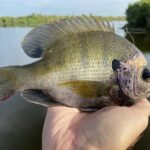If you want to take your bluegill fishing to the next level, you need to understand the bluegill spawn.
This article is a deep dive into the temperature, habitat and biology of the mighty bluegill.
We’ll cover a wide range of topics…all of which will make you a more informed and more successful angler.
This page contains affiliate links. As an Amazon Associate, I earn from qualifying purchases.
Table of Contents
Bluegill Biology
Pound for pound the bluegill, Lepomis macrochirus, are one of the most fierce and powerful fish that swim. Bluegill are more often than not keyed to structure, which makes them easy to target for both anglers and predators.
When other species prove difficult, bluegill often provides a surefire way to get strikes for anglers of all ability levels.
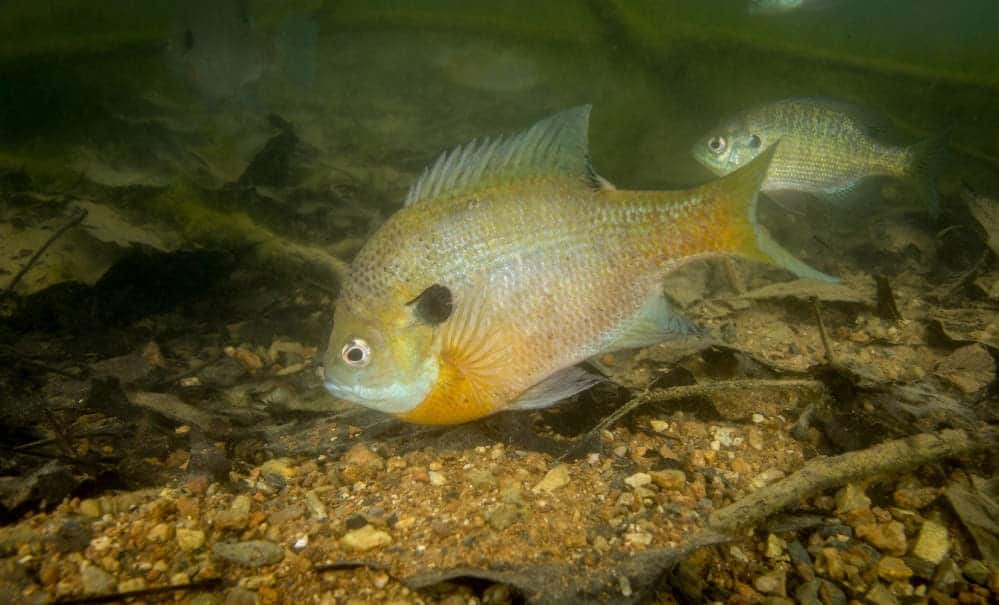
Bluegill are native to the Southeastern United States and Mississippi River watershed. They’ve been introduced to basins from as far north as Canada and south into Northern Mexico. They can live as long as 10 years, with a maximum size of 4.8 pounds and reach 16” in length.
The best places to find bluegill is to find slow moving or protected water near structure. They love docks, timber, or brush near points, creek channels or humps, typically over hard or firm substrates.
Aquatic vegetation can be a draw, but mostly when it’s sparse and scattered. Overhanging trees and a little wind causing some chop on the water give bluegill the security they need to be more aggressive.
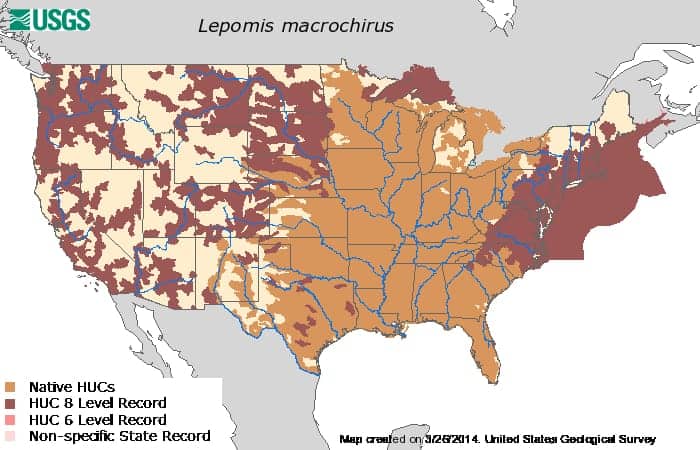
They are opportunistic feeders and will feed on terrestrial and aquatic insects, small crustaceans, and worms. Look for them to key on areas with hard bottom adjacent to some depth change in association with structure.
They’re often prolific and easy to find. Once you find them, it’s on you to determine your favorite angling technique.
When do Bluegill Spawn?
The most important factor that triggers spawning activity in bluegill is water temperature. Depending on where you live bluegill begin spawning when the water exceeds 71.6 F.
In Northeast Georgia, where I live, that might be late-April depending the season. Weather is typically volatile in the spring, but you can typically monitor a nearby USGS gauge for water or soil temperatures.
Once they get going they’ll spawn about every 30 days until the water dips back below 71.6 F.
| Region | Bluegill Spawning Window |
| Southeastern USA | April-August |
| Midwestern USA | May-August |
| Northeastern USA | June- August |
| Western USA | May-August |
This means that when Bluegill spawn, they are very active and prolific; Males often build large congregations of beds in shallow areas where they can be targeted easily by anglers.
Bluegill Spawning Habits
Bluegill can begin spawning when they reach 3-5” in size, which is why fisheries consultants typically recommend this size for initial stocking in ponds and lakes.
They grow rapidly and begin to peak in their spawning activity around age 3-4. From there, growth slows, depending on their food resources.
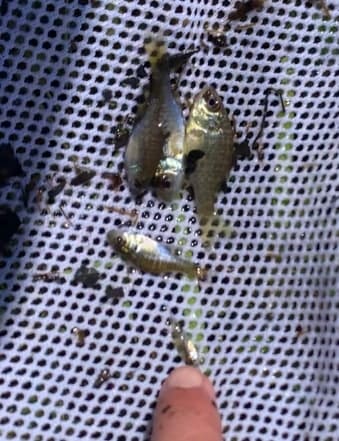
In the photo you see bluegill reproduction from a few spawns. The smallest, transparent bluegill are considered recently hatched and typically less than 30 days old.
Larger size classes all depend on available food resources, but it is not uncommon to see recently hatched, 1-2”, 3-5” and 4-6” bluegill in seine haul pulls in productive ponds and lakes with balanced predator populations.

Spawning locations depend on light penetration, substrate, and cover. In a fertilized or muddy pond you might find bed complexes as shallow as 12-18”, while in deep clear reservoirs you might be looking as deep as 10-15’ deep.
I tend to scout for the appropriate water depth and then look for the best habitat near changes. Where I live, in the foothills of Georgia it’s common to find them on gravel flats next to rocky banks. These provide nice substrate, deeper cover nearby, and usually shallow flats for foraging.
Large colonies typically form if there is continuous similar water depth and bottom composition. Breeding is synchronous, meaning the males build the congregation of beds in preparation for a school of females to arrive all at one time.
Other sunfish are more solitary and thus are not as easy to pattern.
Bluegill typically look for shaded cover, and if in the sun, prefer deeper water. If the bed complex happens to be in full sun it’s best to look for them to be active during low light or cloudy conditions. Otherwise they’ll pull off the beds during the heat of the day.
How Fast Do Bluegill Grow?
When bluegill spawn they can lay anywhere from 10,000 to 60,000 eggs in nests that are typically in 3-5’ of water. The eggs sink to the bottom of the nest and adhere to the substrate.
They typically hatch in 40 hours depending on water temperatures. Eggs hatch 64.4-96.8 F. Feeding begins just under ¼” in length.
They begin feeding by focusing on zooplankton such as nauplii, cyclopoids, and rotifers. In well managed ponds they grow quickly. Depending on the forage base bluegill can reach sexual maturity in less than a year, but in most lakes they take 3-4 years to reach maturity.
Growing Big Bluegill in Your Pond or Lake
Developing trophy bluegill hinge on maintaining adequate food and through reducing competition.
The best way to push the population is to maintain a bass heavy pond. This means you intentionally stock and manage your harvest for a pond full of small bass.
Restricting all bass harvest will quickly drive the population in this direction. Once your bass are stunted at 10-12”, you’ve got the perfect situation to begin developing trophy bluegill.
Bluegill can be fed to increase their size using a variety of floating pellets. Something with a protein content exceeding 30% is ideal. I once worked at a facility where my boss enjoyed bluegill fishing every afternoon. He’d head down to the pond each afternoon with a cane pole and a secret bait.
Purina Dense Culture pellets that he spent the night before drilling holes in. The pellets were a little larger than others, and proved to be a deadly combination when he had the feeders set to go off when it was time to head home for dinner.
When Is The Best Time To Catch Bluegill?
Bluegill begin feeding when the water temperature reaches 50 degrees Farenheit. For most fish species, this is the temperature where a fishes metabolism begins to activate. They’ll feed slowly, but as temperatures rise, they’ll quickly begin to build their reserves for the spawn.
Their optimum growth and highest metabolism hits at 86 F. You could presume they’d be feeding up and entering prespawn as temperatures near 70F.Bluegill are an excellent fish for the beginner to target as they willingly take a variety of baits

Many anglers focus on full moon and new moon phases for best results. In coastal and saltwater systems there is always a tidal influence which can be greatly impacted by the moon phase.
In inland freshwater systems many experts feel there is no science behind moon phase and fishing. Anglers, however, are very passionate about the impact of moon phases.
I personally like to fish around full moons for bluegill during the summer, especially during periods of low pressure. I use a simple barometric pressure gauge to monitor weather patterns in my area and it’s one of my favorite tools for fishing.
Does it come from better visibility for anglers and the fishes at night, or is it merely a correlation of increased confidence from anglers lending towards greater effort? In my experience, anything you can do to add confidence and focus produces more fishes.
| Fact | Description |
|---|---|
| Spawning season | Typically occurs in late spring or early summer when water temperature reaches around 70°F |
| Nest building | Male bluegills build nests in shallow water by fanning their tails to create a circular depression in the substrate |
| Nest defense | Males aggressively defend their nests from other fish, including other bluegills and even larger fish like bass |
| Courtship behavior | Males attract females to their nests by performing a “nesting dance” where they swim in circles and flare their fins |
| Egg laying | Females lay eggs in the nest and the male fertilizes them |
| Parental care | Male bluegills guard the nest and fan their fins to provide oxygen to the eggs and fry |
| Hatching time | Bluegill eggs typically hatch within 3-5 days |
| Fry development | Bluegill fry stay in the nest for a few days before swimming out to form schools and feed on plankton |
| Spawning success | Bluegills have high reproductive potential and can spawn multiple times per season, leading to large populations in suitable habitats |
Best Bluegill Baits
Red wigglers, wax worms, crickets, or meal worms. Add them to a small size 10-12 hook with just enough shot to make it sink slowly and you’ve got something they can’t resist. I love to free line baits for a more subtle presentation, but many prefer the float.
Whatever you choose, try to use some stealth and practice your casting for a quiet subtle presentation.
Getting your bait to the right spot without a lot of commotion is one of the most under-appreciated facets of fishing success. In areas of high pressure, it often makes the difference in bites versus no bites.
Bluegill Tackle
When it comes to the best bluegill lures nothing beats a size 0-2 Mepps XD spinner or Roostertail up to 1/8 oz. As a kid I loved fishing the Heddon Zara pooch, teeny torpedo, Rebel crickhopper or other 1/8 oz topwater baits.
Small minnow style jerkbaits or crankbaits are hard to beat such as those sold by Rapala or Jackall Brothers.
When it comes to flies my pal Rich got me hooked on slow sinking dragonfly imitations, size 10 poppers, size 10-14 wooly buggers or San Juan worms.
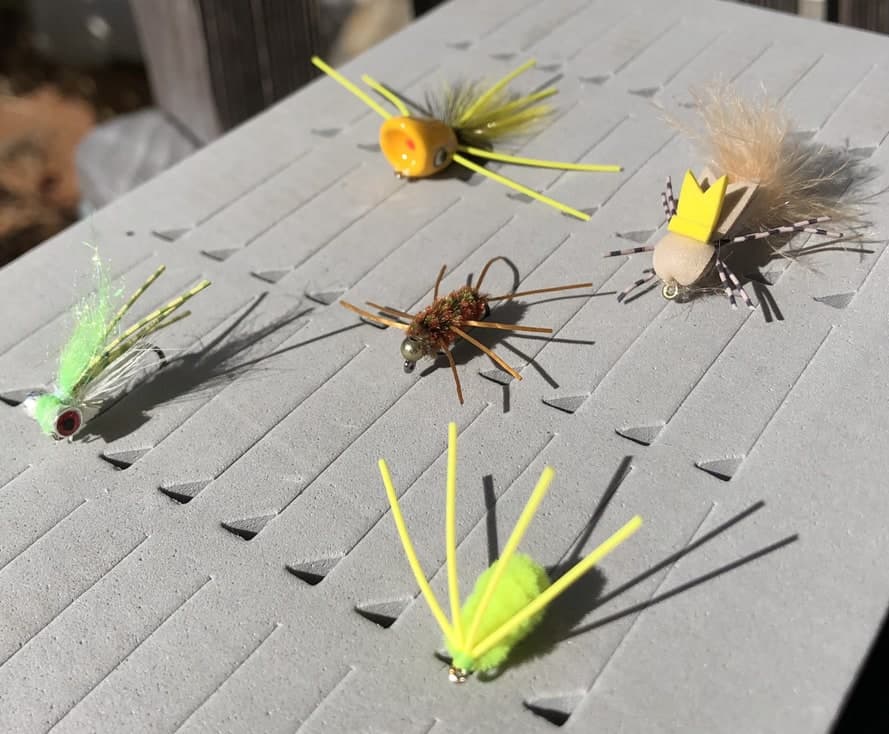
Jake Darling at Unicoi Outfitters is a good friend and fly guide. As you can see from the pics he’s put them into action, catching some nice bluegill on a nice 125-acre lake we help manage near Cleveland, Georgia.
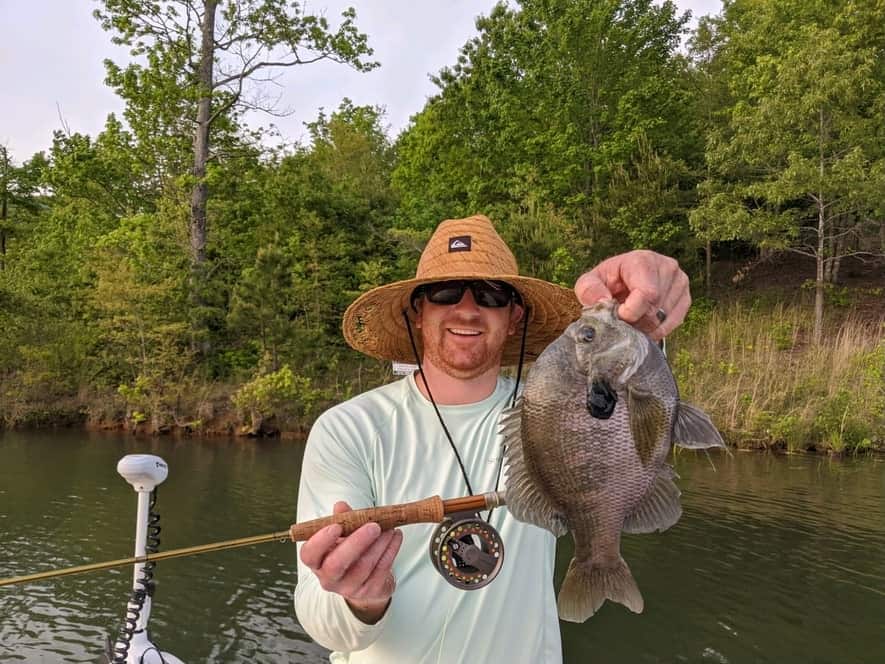
Bluegill Fishing Tips
A big key to catching bluegill comes with repetition. You’ve gotta put the time in on the water or in the backyard to hone your casting skills. Catching fish that key in on structure requires that you can present your baits effectively.
I tend to use a fast action or extra-fast action tipped rod to increase my casting accuracy. Getting the bait deep into the cover and accurately placed makes all the difference in the number of bites I receive.
I’m also not afraid to downsize my line to 2-4 lb test. The lighter the line, the more bites you’ll get. Some folks love the fluorocarbon, but I’ve found I do better with lighter monofilament.
It has some stretch, which often makes all the difference keeping a nice fish on using light line.
See Also: What Is The Best Fishing Line For Bluegill?
For me I typically tend to have a few baits tied when feeling out a new body of water to determine what the fish are looking for.
Sometimes it’s easy to find them and pick them apart with live bait. Other times you need to have something like an inline spinner to cover water looking for nice schools of fish.
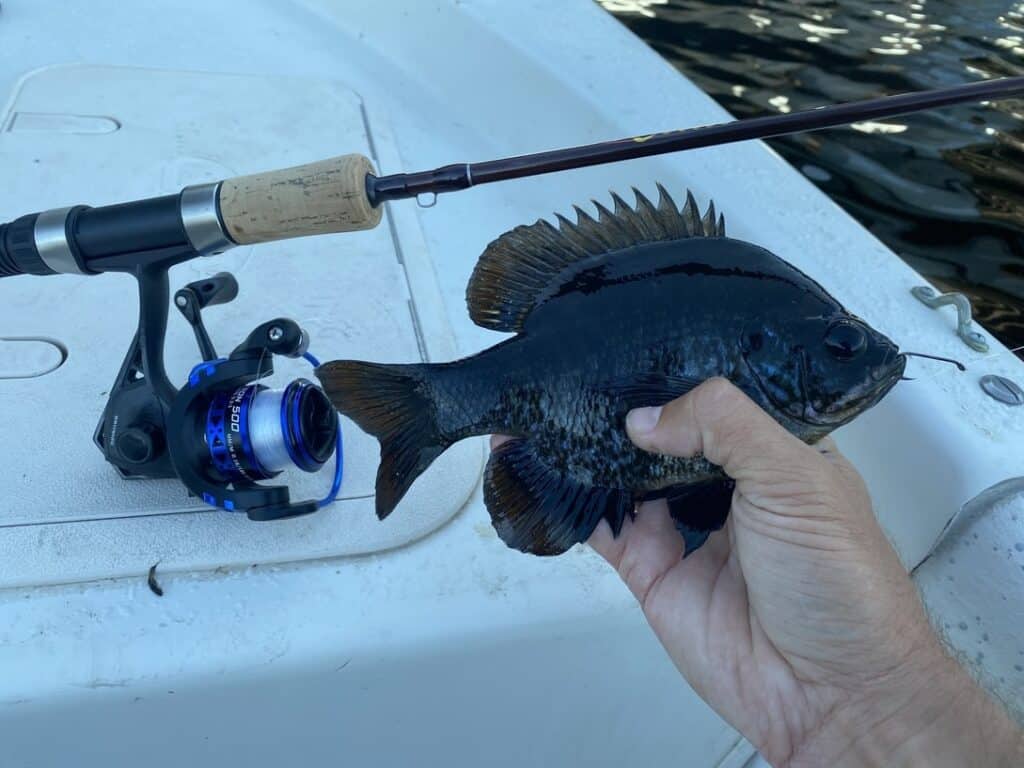
Once you find them you can slow down and begin to pick the structure apart with slower baits. Don’t forget in early spring those suspending jerkbaits are hard to pass up for any fish in the 50-60 F range. Once it get’s 70+ degrees I tend to switch exclusively to topwater for more fun.
When fishing spawning beds it’s very important to keep your presentation subtle. Like bass, bluegill will actively defend their beds.
You can trigger them with reaction baits moving quickly and erratically to initiate a territorial response, or you can drop your bait in the bed to trigger a cleaning response.
Either way, the bluegill will do their best to defend their eggs. In areas of heavy structure, I tend to use reaction baits to trigger bites, since I’m more often than not in a drifting kayak, where holding something like a live bait under a cork is more impractical.
Conclusion
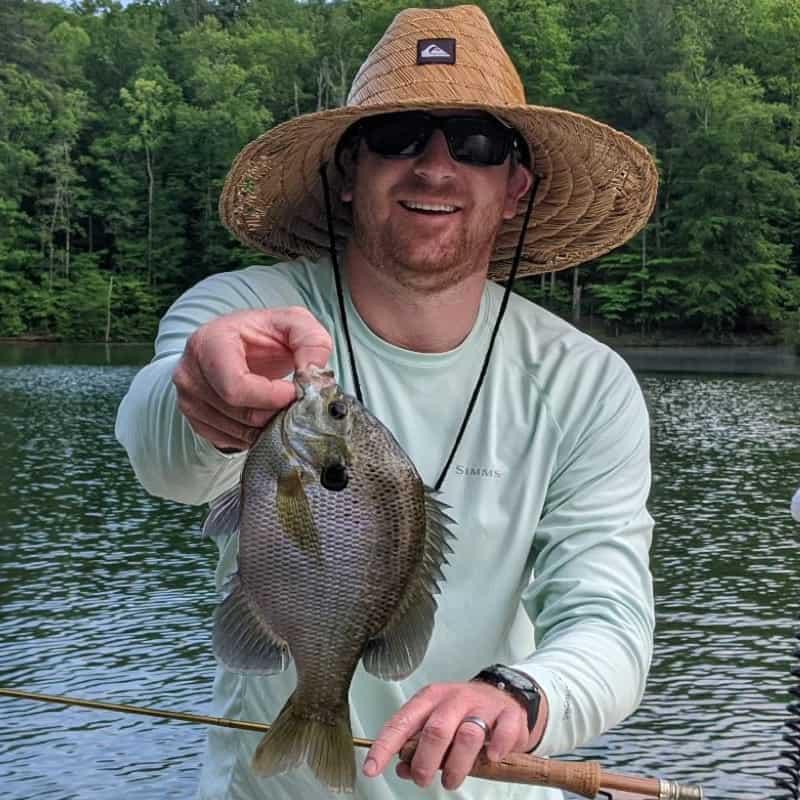
At the end of the day, few fish can rival trophy bluegill caught on topwater on 2 lb test or your favorite ultralight.
One of my favorite techniques has been to downsize to a 36” ice fishing rod to really make it fun. On the right pond, you can experience hours of fun pecking off small bass and huge bluegill.
That’s the thing about fishing for bluegill….catch rates are usually extremely high.
You May Also Like: How To Find Bluegill Beds & Time The Spawn
If you haven’t guessed yet, I love fishing and everything about it!
To learn more about why I started Panfish Nation, visit the About page and follow along on Social Media:


Download a copy of my FREE Lure Color Selection Chart & Knot Guide!
Stay up to date with fishing reports, tackle reviews, industry news, and much more! We respect your privacy, unsubscribe at any time.
Related Posts
- Crazy Facts About the World Record Crappie

- What Size Hooks for Smallmouth Bass? Quick Guide

- Large and in Charge-Mouth: 10 of the Best Bass Lures of All Time (And Where to Buy Them)

- Emperor of the Sun(fish): What You Need to Know About the World Record Bluegill
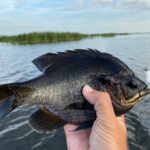
- Coppernose Bluegills: How They’re Different from Common Bluegill
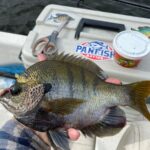
- Bluegill vs Brim: Differences & Terminology, Explained!
